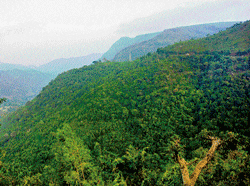
It was still dark and cold, as we reached Visakhapatnam quite early in the morning. Although the lassitude from disturbed sleep of the overnight train journey had wearied us down, the thought of an exciting journey ahead kindled a new energy.
We were heading to Araku, a scenic hill station in Andhra Pradesh. The tour guide from the state’s tourism department welcomed us and rushed us to freshen up and have a hot cup of coffee before boarding the train. By 7 am, we were already seated by windows, ready to drink in the beauty of nature. During our week-long tour of the Visakhapatnam district, the visit to Araku had gained top priority and so it was our first choice.
Araku Valley, nestled in the hills of Eastern Ghats at 114 km from Visakhapatnam, is connected by road as well as rail. However, the train journey is often suggested as mandatory, with the breathtaking sights of the hills, valleys and a blanket of greenery enveloping them.
The journey is similar to the one in the toy trains of Ooty or Shimla. As the train chugged up slowly, the vistas began to open up. The Eastern Ghats run along the eastern coast of India, similar to the Western Ghats. But this chain of mountains is not continuous and is also not as high. The peaks of Jindhagada and Galikonda are in the vicinity of Araku, which makes it an interesting landscape of rolling green hills and deep ravines. With a few rivers and an occasional waterfall, the valley has everything to make it a heavenly paradise.
Eventful journey
The track passing through 58 tunnels carved out of the hilly terrain and over 84 bridges made the travel all the more thrilling. The tourists who form the major crowd, irrespective of their age, cheered and screamed animatedly each time the train passed through a tunnel. Alighting at Araku after a three-hour enjoyable journey, we felt rejuvenated. As such the post- lunch session was utilised not to rest, but to walk around the place.
Despite its popularity and the tourist inflow, Araku has retained a primitive charm and culture largely because of its tribal inhabitants. It was small wonder that as part of the package, we were introduced to their traditions through a session of Dhimsa, the dance of tribal women.
Continuing our tryst with their lifestyle, we took a tour of the tribal museum. The exhibits that included life-size images of men, women, their dwellings, utensils and ornaments transported us to an entirely unknown world of tribals. A stroll along the Padmapura Botanical Gardens brought us to the end of day one.
Waking up to the sweet twitter of birds, the morning became more eventful with a trek along the birdwatcher’s trail to an abandoned settlement of tribals. After a rather spicy breakfast, we headed towards Paderu, a tiny township famed for the Modakondamma Temple, with a huge statue of the village deity. We took a detour on the way to get a glimpse of the swathes of coffee plantations. Araku is known for its organic coffee farming, with some brands enjoying even a global market.
On our way back, we stopped briefly at Chaparai Falls. Though it is just a drop in the flow of Gosthani river, the surroundings of the valley with slopes of green trees make it attractive. The busy, weekly shandy we passed through gave us yet another glimpse of the local culture as we reached the Anathagiri Resorts for a well-deserved lunch.
The restaurant itself, set in a picturesque locale, affords endless views as you dine. The drive after lunch brought us to the Tatiguda Falls, which can be reached after a short walk through the countryside. The waterfall sliding down in three distinct steps is charming, but for the innumerable names of unscrupulous visitors all over the rock.
The last event of the day was the view from the Galikonda point. With high hills of the Eastern Ghats rolling along the densely wooded valleys, the panoramic views we enjoyed made a lasting impression of the visit to Araku Valley.